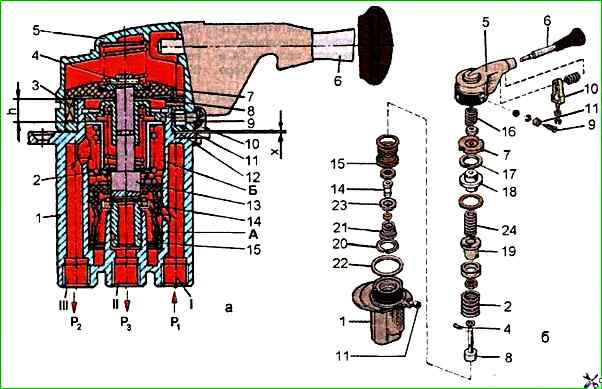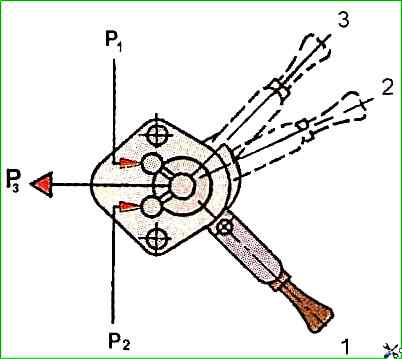Brake valve of the ZIL-5301 parking brake system
The valve can be installed to the right of the driver's seat or on the dashboard
Air coming out of the valve during braking is discharged to the outside through the air duct connected to the atmospheric outlet II
Dismantling, assembling and adjusting the valve
Install the valve in a vice with soft jaws and secure it by the housing 1 (Fig. 1) with the cover 5 facing up.
Unscrew the axles 9 of the rollers 11, holding the cover 5 with your hand, and remove it with the spring 16.

Then, using a center punch, carefully knock out pin 4 and remove rod cam 7 with washer.
Using round-nose pliers, remove thrust ring 17 and remove rod guide 18, springs 2 and 29, spring plate 19 and rod 8 from housing 1.
Release housing 1 of the tap from the vice and remove piston 15 with valve 14 assembled using a wooden mandrel inserted through atmospheric terminal III.
To disassemble valve 14 from piston 15, use round-nose pliers to remove thrust ring 20, holding piston 15 in your hand and being careful, since there is a compressed conical spring 21 in the piston.
After disassembling the brake The parking brake system valve must be washed with clean gasoline or acetone, dried and carefully inspected.
There must be no cracks, hairlines or other visible defects on the surface of the body parts.
The parts must be cleaned of rust and burnt-on deposits. All rubber parts must be replaced with new ones. Springs should be painted with varnish or paint.
Before assembling the faucet parts, lubricate them with a thin layer of TSIA-TIM-221 grease by hand.
Valves, rubber sealing rings and other rubber parts should be assembled carefully, preventing damage.
The presence of scratches, cuts and other defects on the surface of these parts is not allowed.
Assembly of the faucet should begin with the subassembly of valve 14 with piston 15, placing it on a flat table.
Install valve 14, support washer 23 in the piston, orienting its flange towards the rubber element of the valve, conical spring 21 and, using round-nose pliers, thrust ring 20.
Then it is necessary to clamp body 1 in a vice and install piston 15 in it in assembled with valve 14 (see Fig. 1). Install spring 2 with plate 19.
Assemble rod 8 with washer, spring 2, plate 19 and install it in housing 1.
Then install spring 24 and rod guide 18, paying attention to the presence of a rubber sealing ring on it.
After this, if necessary, you can adjust the force of spring 2 (see Fig. 2).

To do this, you need to compress the spring 2 to the size x = 13.8 ÷ 13.9 mm from the upper end of the housing 1 to the upper end of the plate 19. In this case, the spring force should be equal to 130 ÷ 155 N.
If this force is less than the specified value, then install the adjusting washers (part. 100-3537095 or 100-3537097), bring the spring force to the required value.
Installing washer 1003537095 increases the spring force by 42.5 N and provides a pressure drop of 0.035 MPa, and installing washer 100-3537097 - by 22.5 N and 0.021 MPa, respectively.
After adjusting the springs, it is necessary to put on the cam of the rod 7 and, being careful, install the pin into the rod 8 using a punch 4.
Next, install spring 16 and cover 5, having first inserted rollers 11 into it. Screw in two axles 9, securing cover 5 with them.
Measure the minimum gap between cover 5 and washer 22, which should not exceed 0.15 mm.
If this gap is larger, then combine adjusting washers part. 100-3537092 0.15 mm thick, part. 100-3537093 0.2 mm thick and part. 100- 3537094 0.3 mm thick and place on washer 22 between cover 5 and body 1 so that the gap does not exceed the specified value.
Washer 22 part. 100-3537091 0.5 mm thick remains lying below. The washers must be lubricated with CIATIM-221 grease.
Check the ease of returning the handle to its original position when it is tilted at an angle of 40÷45° and 65÷70°.
Checking the functionality of the crane
Install the tap on the test bench and connect it according to the diagram shown in Fig. 2.
Put air under a pressure of 0.75 MPa into the outlet, while the pressure in outlet 1 should be equal to the pressure in outlet 1.
Move the tap handle from position 1 to position 3 and back three times.
Then slowly move the tap handle from position 1 to position 3.
When moving the handle, there should be no jamming and it should move easily! be fixed in position 3.
When turning the handle from position 1 by an angle of up to 70°, it should automatically return to position 1.
Slowly turn the handle from position 1.
When turning the handle by 8-10°, the pressure in output II should drop, but not more than 0.15 MPa.
With further rotation of the handle, the pressure in output II should smoothly decrease to 0.
To check the tap for leaks, air must be supplied under a pressure of 0.75 MPa to output I with the handle in positions 1 and 3.
When soaping, the appearance of air bubbles is not allowed for 1 min.





